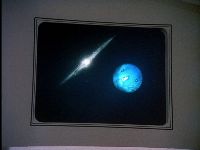Alien Planets
by Martin Willey

The first alien planet encountered by the Moon was Meta (above), which was passing through Earth's solar system (this is not clear in the episode). During the six years of travelling through deep space, the Moon passed 22 planetary systems. In order, these planets were:
| # | Planet | Days since Breakaway | Interval | Episode |
|---|---|---|---|---|
| 1 | Terra Nova | Matter Of Life And Death | ||
| 2 | Earth | Another Time, Another Place | ||
| 3 | Zenno | Missing Link | ||
| 4 | Piri | Guardian Of Piri | ||
| 5 | Ariel | The Last Sunset | ||
| 6 | Atheria | Collision Course | ||
| 7 | Ultima Thule | Death's Other Dominion | ||
| 8 | Retha | The Full Circle | ||
| 9 | War Games planet | War Games | ||
| 10 | Betha & Delta | The Last Enemy | ||
| 11 | Arkadia | The Testament Of Arkadia | ||
| 12 | Psychon | 342 | Average 31 days between systems in Year 1 | The Metamorph |
| 13 | Vega | 515 | 173 days since Psychon | One Moment Of Humanity |
| 14 | All That Glisters planet | 565 | 50 days since Vega | All That Glisters |
| 15 | Luton | 892 | 327 days | The Rules Of Luton |
| 16 | New Earth | 1095 | 203 days | New Adam, New Eve |
| 17 | planet D | 1150 | 55 days | Brian The Brain |
| 18 | Chrysalis planet | 1288 | 138 days | The A B Chrysalis |
| 19 | Sunim | 1702 | 414 days | A Matter Of Balance |
| 20 | Tora | 2012 | 310 days | The Seance Spectre |
| 21 | Ellna | 2306 | 294 days | Devil's Planet |
| 22 | Immunity Syndrome planet | 2310 | 4 days since Ellna;
average 179 days interval in Year Two; 105 days in both series |
The Immunity Syndrome |
In Matter Of Life And Death, Kano estimates that the Moon will pass by 10 million planets in 2543 years, including 3600 Earth-type planets. That's a solar system every 11 days, with an Earth-type planet every 8 months. The actual rate was ranged from over a year (between the The A B Chrysalis and A Matter Of Balance), to just 4 days pass between the planets in Devil's Planet and The Immunity Syndrome. To help the Moon on it's way, there were unexpected black suns (Black Sun) and space warps (twice in Another Time, Another Place, once in Collision Course, once prior to The Metamorph, once in Space Warp).
Among the planets were ice worlds (Ultima Thule & Vega), desert worlds (Tora, All That Glisters planet), forested Earth type planets (Retha, Sunim, Luton, Ellna, New Earth, The Immunity Syndrome planet), dead worlds (the war-blasted Betha & Delta, volcanic Psychon, Earth in Another Time, Another Place, Arkadia) and a few more bizarre environments (Piri, Zenno). Almost all have oxygen atmospheres; the exceptions are Kreno and the Chrysalis Planet (both chlorine), planet D, and Tora.
The vast majority of alien species are humanoid (perhaps all descended from the Arcadian exodus from their dying world). Some humanoid species have distinctly alien features, notably the coneheads from War Games and the captured aliens on Psychon and Luton. A few non-humanoid aliens are seen: the dragon from Dragon's Domain, Maya's rubber suit monsters, the globs in The Bringers Of Wonder, the trees from Luton and the rocks from All That Glisters. There are also an assortment of aliens who have no physical form: the "I" entity in The Immunity Syndrome, the Zoref entity in Force Of Life, and the visitors from Triton. We never find out what the aliens from Ariel, Kalthon, Piri or Jarak's world look like.
Only a few aliens are not oxygen breathers: the chlorine breathing chrysalides are remarkably humanoid but must be radically different biologically; the Kreno animal is also a chlorine breather; the globs from The Bringers Of Wonder do not require any atmosphere; and the Psychon animals seen in Space Warp and The Bringers Of Wonder store oxygen when on the lunar surface. A surprising number of planets seem to have tiny populations: Zenno (3), Betha (5) & Delta (1), the War Games conehead planet (2), Psychon (2), Golos (3), the Chrysalis planet (4). Most are more advanced than Earth, notably Atheria in Collision Course and Zenno in Missing Link.
Four federations of planets exist: Croton, Sidon, the Dorcon Empire and Taybor's Trading Worlds. Triton, Betanon and the Archanons also explore space extensively. Psychon has had contact with the Dorcon Empire and the Trading Worlds, as well as a number of other planets such as Kreno and Archanon.
Copyright Martin Willey